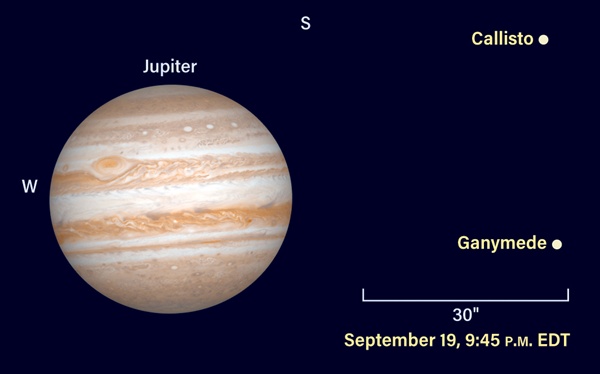The Sky This Week from September 13 to 22 – Astronomy Magazine
Ganymede and Callisto pass in the night
Jupiter’s two largest satellites line up north-south of each other on the 19th, when you’ll be able to notice their relative positions change in just a few minutes.
Astronomy: Roen Kelly
The waning gibbous Moon rises in the east shortly after 10 p.m. local daylight time. Wait about an hour for it to climb clear of the horizon and you’ll see it nestled just above the background stars of the Hyades star cluster in the constellation Taurus the Bull. Binoculars will deliver the best views of this pretty conjunction. As the night progresses, you’ll see the Moon draw closer to 1st-magnitude Aldebaran. This star, which appears to anchor the V-shaped Hyades, actually lies only half as far away.
Jupiter’s four bright moons all orbit in the planet’s equatorial plane, so from our perspective, they usually appear in a straight line that runs east-west. But this symmetry breaks down once in a while. If you target the gas giant through a telescope this evening, you’ll notice its two biggest moons lined up north-south of each other. If you keep watching, you’ll see Ganymede and Callisto change relative positions in as little as five minutes.
Friday, September 20
Any clear evening this week is a good time to explore the constellation Sagittarius the Archer. This star group lies due south and at peak altitude during the latter stages of twilight and remains conspicuous until after 10 p.m. local daylight time. The brightest stars within the constellation form a distinctive asterism in the shape of a teapot. The central regions of the Milky Way pass through Sagittarius, so it’s always worth exploring this region through binoculars or a telescope.
Saturday, September 21
Last Quarter Moon arrives at 10:41 p.m. EDT. It rises about 20 minutes before midnight local daylight time and will climb high in the southeast as dawn approaches. During this period, our half-lit satellite slides eastward along the border that separates the constellations Orion the Hunter and Gemini the Twins.
Sunday, September 22
Although autumn arrives with the equinox tomorrow, the Summer Triangle remains prominent in the evening sky. Look high in the west after darkness falls and your eyes will fall on the brilliant star Vega in the constellation Lyra the Harp. At magnitude 0.0, Vega is the brightest member of the triangle. The second-brightest star, magnitude 0.8 Altair in Aquila the Eagle, lies some 35° southeast of Vega. The asterism’s dimmest member, magnitude 1.3 Deneb in Cygnus the Swan, stands about 25° east-northeast of Vega. For observers at mid-northern latitudes, Deneb passes through the zenith at approximately 9:30 p.m. local daylight time, about an hour after twilight ends.







